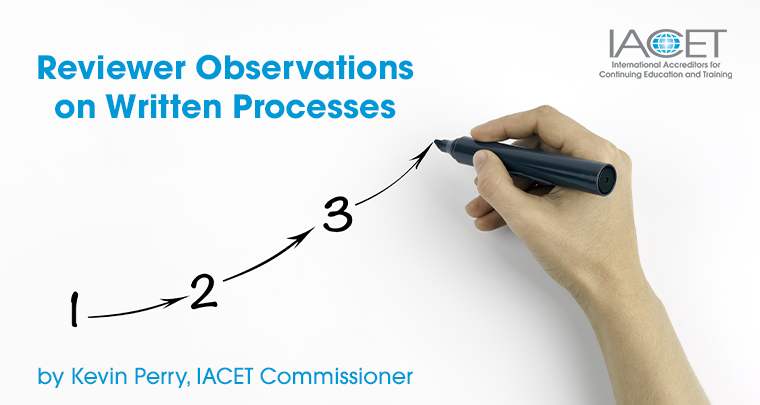Reviewer Observations on Written Processes

As an IACET Commissioner, I’ve reviewed several Initial Accreditation applications over the past few months and thought I would share an observation that may be helpful to those preparing an application.
A common issue I see with Initial Accreditation applications is the level of detail provided in the Elements that require a process. There are 19 Elements of the IACET Standard that require a written process, followed in most cases by evidence that verifies you are effectively implementing the process. This is covered extensively in IACET’s Accreditation Assistance Webinar, which all applicants are encouraged to attend. See https://iacet.org/events/ap-application-assistance-webinars/ for upcoming offerings. In this one-hour webinar, we explain how the IACET Standard specifies that every process needs to explain the Who, What, When, How, and with what Tools. Who is responsible for implementing the process? What does the process accomplish? How is the process implemented in detail via a step by step procedure? When must the process or certain steps of the process be completed or how often must the process be done? And finally, what tools are used to perform the process such as forms, templates, databases, LMS systems, email, etc.?
Most applicants, particularly those who attend the Accreditation Assistance Webinar, do a good job creating a process template they use for every process. In many cases however, the detail on the How is missing. I see many process documents that specify who is responsible, what is done, and perhaps when it’s done but the step-by-step procedure explaining how it’s done is missing. As an example, Element 2.3 requires that “The Provider shall have a process to disseminate information including, but not limited to, the learning outcomes, criteria to earn the IACET CEU, prerequisites and other requirements in advance of the learning event.” The Guidance that follows offers this additional detail: “Information should include event descriptions, event logistics, learning outcomes, learner assessments, and criteria for earning the CEUs. Additional information could include program content, prerequisites, learning methodology, technical equipment and related skills requirements, support services, and payment policies. Information can be delivered in a variety of formats, such as email, letter, website, marketing materials, catalogues, etc.”
I recall an application where the submitted process explained that the Training Coordinator is the responsible person, and the purpose of the process is stated as providing learners with important information in advance of the learning event. So far so good. We know the Who and the What. Then the entire procedure is:
- After registering, learners are sent information about course completion and CEU requirements.
- If learners have questions, they may email or call the Training Coordinator.
We assume the Training Coordinator sends the information but missing is detail explaining how it is sent (via a registration confirmation email for example?) and when. We are also left wondering how learners are informed of the other important information from the Guidance including course description, learning outcomes, logistics, learning assessment method, any prerequisites, and any technical/technology requirements. And for learners who email or call the Training Coordinator, are there any requirements around response time?
An example of a more complete procedure for this process would be:
- Within 24 hours after learner registers, Training Coordinator emails learner Registration Confirmation email (template located in sharepoint folder “Learner Emails”) that includes information on:
- Course dates and times
- Logistics
- CEUs awarded
- Required 70% minimum score on final exam to earn CEUs
- Payment status (paid in full or balance due)
- Email, phone number, and Training Coordinator contact info for help with any questions
- Links to website for full course description that includes learning outcomes, prerequisites, and technology requirements
- For learners who email or call for assistance or more information, Training Coordinator will respond to learner via phone or email within 48 hours.
Then the process is appended with a template copy of the Registration Confirmation email, which ensures that the Training Coordinator is using the proper email plus it enables Reviewers to verify that this email includes everything the process promised.
Keep in mind when writing processes that they should not be written just to satisfy IACET Reviewers. Instead, they should be written more as a job aid or job training tool, providing sufficient detail for designated staff to implement the process without having to ask many questions. With that in mind, two questions to ask yourself after drafting a process are (1) does it explain the Who, What, When, How, and with what Tools and (2) can the assigned team member, including a new hire, execute the process without having to ask exactly how do I do this or where do I find that? Also, the Guidance section of each Element of the Standard have been written to provide everything each Element requires. So a third question to ask is does the drafted process includes everything the Guidance has specified? You can also review examples of effective process documents in the Resources area of iacet.org
Hopefully this is helpful detail for drafting processes or for already Accredited Providers, when re-writing process documents. If you are still considering applying to become an IACET Accredited Provider, it does take some work but is not as daunting as you may think. And being an Accredited Provider significantly increases your credibility with both external and internal constituents, allows you to offer the official CEU, and eliminates the guesswork or debate about how to structure and operate a world class continuing education/training organization. Join us for an upcoming Accreditation Assistance Webinar for the complete details.
About the Author

Kevin Perry is a continuing education & training consultant specializing in the non-profit environment serving technical industries and higher education. His expertise includes growing a continuing education business through effective strategic planning, management, leadership, budgeting, and acquisitions.
At the end of 2018, Kevin retired as Director of SAE International’s Professional Development division, a position he held since 2001. In this capacity, he led a staff that plans and delivers public training courses, in-company training, and a variety of multimedia/distance learning products for engineers who serve the automotive, aerospace, and commercial vehicle industries. In 2014, he assumed management of Effective Training, Inc., a firm that SAE acquired, which focuses on geometric dimensioning and tolerancing training products. Also in 2014, he established Probitas Authentication, a new SAE business that certifies aerospace auditors and training providers. In 2015, Kevin led an effort to acquire the aerospace auditor and training provider business from the principal competitor to Probitas and in 2018 he led the acquisition of CALISO, an online ISO-standards training company.
Prior to his role as Director, Kevin worked as an Education Program Developer where he invented SAE’s Engineering Academy format, which earned the Award of Excellence from the American Society of Association Executives (ASAE).
Before joining SAE, Kevin worked in the continuing higher education field for nearly 12 years at both Penn State University and Duquesne University where he held positions as program developer, administrator, and marketing director. His educational credentials include a B.S. in Education and M.Ed. in Counselor Education from Penn State University, and Ed.D. in Administrative and Policy Studies from University of Pittsburgh. He also holds an MBA Essentials Certificate from the University of Pittsburgh Katz School of Business and Basic, Intermediate and Advanced Digital Badges from the International Accreditors for Continuing Education and Training (IACET).
His service work includes Board of Regents member for Baker College’s Graduate School and Online College, Governing Board Vice-Chair of the Michigan Alliance for Greater Mobility Advancement (MAGMA), and Education and Training Track Committee member for the Council of Engineering and Scientific Society Executives (CESSE). From 2014 to 2018, he served on the IACET Board of Directors during which time he also chaired their Awards Committee and helped develop their Digital Badging Taxonomy. In 2019, he became an IACET Commissioner.
